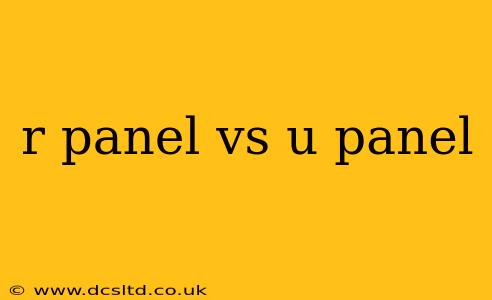Choosing the right type of wall panel for your construction project is crucial for both aesthetics and structural integrity. Two popular options are R-panels and U-panels, each with distinct characteristics that make them suitable for different applications. This comprehensive guide will explore the key differences between R-panels and U-panels, helping you make an informed decision.
What is an R-Panel?
R-panels, also known as ribbed panels, are characterized by their rigid, corrugated profile. This design provides exceptional strength and durability, making them ideal for applications requiring high resistance to impact and environmental stresses. The raised ribs create stiffness, reducing the need for extensive internal framing in some instances. R-panels are frequently used in:
- Exterior cladding: They offer excellent protection against the elements, resisting wind, rain, and snow.
- Industrial buildings: Their strength and durability make them well-suited for warehouses, factories, and other industrial structures.
- Agricultural structures: R-panels withstand harsh weather conditions common in agricultural settings.
What is a U-Panel?
U-panels, or insulated metal panels (IMPs), are a more sophisticated type of wall panel. They consist of a metal exterior skin, a core of insulating material (like polyurethane or polyisocyanurate), and another metal interior skin. This sandwich construction provides superior thermal insulation compared to R-panels. Key applications include:
- Cold storage facilities: The excellent insulation properties of U-panels are essential for maintaining consistent low temperatures.
- Cleanrooms: Their smooth surface and airtight seal minimize dust and contamination.
- Commercial buildings: U-panels offer energy efficiency, leading to lower heating and cooling costs.
R-Panel vs. U-Panel: A Detailed Comparison
| Feature | R-Panel | U-Panel |
|---|---|---|
| Structure | Single-layer corrugated metal | Insulated sandwich panel (metal/insulation/metal) |
| Insulation | Low | High |
| Strength | High | Moderate (depends on core and skin thickness) |
| Cost | Generally less expensive | Generally more expensive |
| Weight | Lighter | Heavier |
| Thermal Performance | Lower | Higher |
| Ease of Installation | Relatively easy | Can be more complex |
| Maintenance | Low | Low |
What are the advantages and disadvantages of each?
Advantages of R-Panels:
- Cost-effective: Generally cheaper than U-panels.
- Durable and strong: Withstands significant impact and weather.
- Relatively easy to install: Faster construction time in many cases.
Disadvantages of R-Panels:
- Poor insulation: Leads to higher energy costs.
- May require additional insulation: To meet building codes or desired thermal performance.
- Not suitable for all applications: May be insufficient for cold storage or cleanrooms.
Advantages of U-Panels:
- Excellent insulation: Significantly reduces energy consumption.
- Improved thermal performance: Maintains consistent interior temperatures.
- Aesthetically pleasing: Available in various colors and finishes.
Disadvantages of U-Panels:
- Higher cost: More expensive than R-panels.
- Installation complexity: May require specialized tools and expertise.
- Heavier: Requires a more robust support structure.
Which type of panel is right for my project?
The choice between R-panels and U-panels depends heavily on your specific project requirements. Consider factors such as:
- Budget: R-panels are typically more affordable.
- Climate: U-panels are ideal for extreme climates where energy efficiency is paramount.
- Application: U-panels are better suited for applications demanding high insulation.
- Aesthetic considerations: Both offer various color and finish options.
What is the difference in the lifespan of each panel?
Both R-panels and U-panels, when properly installed and maintained, offer a relatively long lifespan. The actual longevity depends on factors such as material quality, environmental conditions, and maintenance practices. With proper care, both can last for many decades.
How much does each panel cost?
The cost of both R-panels and U-panels varies significantly depending on factors like size, material specifications, and quantity ordered. It's best to obtain quotes from multiple suppliers to compare pricing.
Which panel offers better insulation?
U-panels offer significantly better insulation than R-panels due to their insulated core. This makes them a far more energy-efficient choice for projects where thermal performance is a key concern.
By carefully weighing these factors, you can confidently choose the type of wall panel that best meets your needs and budget, ensuring a successful and efficient construction project. Remember to consult with a qualified construction professional for personalized advice.
